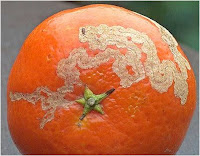2.CITRUS
1. Lime tree borer or orange
borers: Chelidonium cinctum :Cerambycidae: Coleoptera.
- Adult is dull metallic green to dark violet with
a yellow band across the middle of the elytra
2. Orange trunk borer: Anoplophora versteegi :Cerambicidae: Coleoptera.
- Egg: Laid singly in cracks on bark upto 2 feet height
from the ground. Fecundity is 35-85 eggs/female.
- Grub: Feeds on sapwood making
horizontal galleries before entering into centre of the trunk. 267-290 days.
- Pupa: Pupation takes place inside the gallery for 33-43 days.
Adult:
The beetle is large, stout and approximately 21-37 mm long with shyny black
elytra marked with 10-12 white round spots.
 |
| Adult |
3. Citrus psyllid Diaphorina
indica :Psyllidae: Homoptera.
4. Citrus white fly Dialeurodes citri (Aleyrodidae: Hemiptera
5. Citrus black fly Aleurocanthus woglumi :Aleyrodidae: Homoptera.
- Nymphs are scale like,
shiny black and spiny and boarded by a white fringe of wax.
- Adult fly is dark
orange with smoky wings.
- Both nymph & adult feed on cell
sap. It results in the curling of leaves and also premature fall of flower buds
and developing fruits.
 |
| Nymph |
 |
| Adult |
6. Cottony cushion scale Icerya purchasi :Margarodidae: Homoptera.
- Host Range: Apple, almond, walnut, peach, apricot, fig, grapevine, guava, and pomegranate,
etc.,
- Full-grown larva is broadly oval and reddish brown to brick red in
colour. Males are rare, and reproduce by parthenogenesis
- Adult female is a
flat, oval brown to reddish-brown, soft-bodied scale, which lays large, white,
fluted egg-sac.
 |
| Scale Insect |
7. Citrus leaf miner Phyllocnistis citrella :Gracillariidae: Lepidoptera.
8. Citrus caterpillar/
lemon butterfly: Papilio demoleus, P. polytes :Papilionidae:
Lepidoptera.
- Larva: Early stage larva resembles bird dropping. Grown up larva are cylindrical, stout, green and brown lateral bond.
- Adult:Papilio demoleus: Dark brown swallowtail butterfly with numerous yellow marking. P. polytes: Jet black butterfly with row of white spots along the middle part of hindwing. 90–100 mm.
- Defoliation.
 |
| Papilio demoleus |
 |
| Papilio polytes |
9. Fruit
piercing moths Othreis fullonia, O.
materna and O. ancilla :Noctuidae: Lepidoptera.














No comments:
Post a Comment